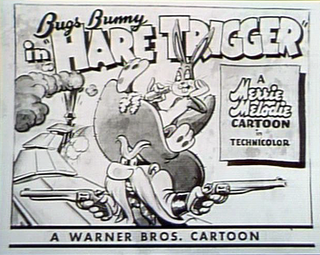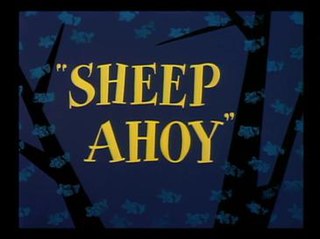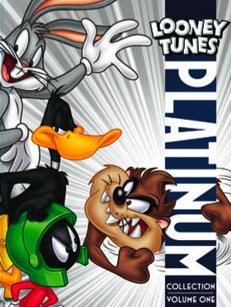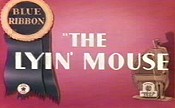Related Research Articles

Looney Tunes is an American animated franchise produced and distributed by Warner Bros. It began as a series of short films that originally ran from 1930 to 1969, along with its partner series Merrie Melodies, during the golden age of American animation. Following a revival in the late 1970s, new shorts were released as recently as 2014. The two series introduced a large cast of characters, including Bugs Bunny, Daffy Duck, and Porky Pig. The term Looney Tunes has since been expanded to also refer to the characters themselves.
Charlie Dog is an animated cartoon character in the Warner Brothers Looney Tunes series of cartoons. The character was featured in nine cartoons between 1941 and 1958. He is generally characterized as a friendly wise guy.

Merrie Melodies is an American animated comedy short film series distributed by Warner Bros. Pictures. It is the partner series to Looney Tunes and featured many of the same characters. It originally ran from August 2, 1931, to September 20, 1969, during the golden age of American animation, though it was revived in 1979, with new shorts sporadically released until June 13, 1997. Originally, Merrie Melodies placed emphasis on one-shot color films in comparison to the black-and-white Looney Tunes films. After Bugs Bunny became the breakout character of Merrie Melodies and Looney Tunes transitioned to color production in the early 1940s, the two series gradually lost their distinctions and shorts were assigned to each series randomly.
Buddy the Gob is a 1934 Warner Bros. Looney Tunes cartoon, the first directed by Friz Freleng. The short was released on January 5, 1934, and stars Buddy, the second star of the series.

I Love to Singa is a 1936 Warner Bros. Merrie Melodies animated cartoon directed by Tex Avery. The short was released on July 18, 1936.

Birds Anonymous is a 1957 Warner Bros. Merrie Melodies animated short, directed by Friz Freleng and written by Warren Foster. The short was released on August 10, 1957, and stars Tweety and Sylvester.

Hare Trigger is a 1945 Merrie Melodies cartoon directed by Friz Freleng. The cartoon was released on May 5, 1945, and features Bugs Bunny. The short featured the first appearance of Yosemite Sam, as well as the first short to credit (almost) the whole animation staff who worked on the short.
Tweety and the Beanstalk is a 1957 Warner Bros. Merrie Melodies directed by Friz Freleng. The voices were performed by Mel Blanc and June Foray (uncredited). The short was released on July 1, 1957, and stars Tweety and Sylvester.

The Looney Looney Looney Bugs Bunny Movie is a 1981 American animated comedy package film with a compilation of classic Looney Tunes/Merrie Melodies Warner Bros. cartoon shorts and animated bridging sequences produced and directed by Friz Freleng, hosted by Bugs Bunny. The new footage was produced by Warner Bros. Animation. It was the first Looney Tunes/Merrie Melodies film with a compilation of classic cartoon comedy shorts produced by Warner Bros. Animation.
From A to Z-Z-Z-Z is a 1954 Warner Bros. Looney Tunes animated cartoon short directed by Chuck Jones. The short was released on October 16, 1954, and stars Ralph Phillips.

Sheep Ahoy is a 1954 Warner Bros. Merrie Melodies cartoon directed by Chuck Jones. The short was released on December 11, 1954, and stars Ralph Wolf and Sam Sheepdog.
Cheese It, the Cat! is a 1957 Warner Bros. Looney Tunes cartoon, directed by Robert McKimson. The short was released on May 4, 1957, and is the second of three McKimson cartoons parodying television's The Honeymooners.
Hollywood Daffy is a 1946 Warner Bros. Merrie Melodies cartoon, starring Daffy Duck. The cartoon was written by Michael Maltese and was released on June 22, 1946.
Half-Fare Hare is a 1956 Warner Bros. Merrie Melodies cartoon directed by Robert McKimson. The short was released on August 18, 1956, and stars Bugs Bunny.
Feather Bluster is a 1958 Warner Bros. Merrie Melodies animated short directed by Robert McKimson. The cartoon was released on May 10, 1958, and features Foghorn Leghorn and the Barnyard Dawg.

Looney Tunes Platinum Collection: Volume 1 is a Blu-ray Disc and DVD box set by Warner Home Video. It was released on November 15, 2011. It contains 50 Looney Tunes and Merrie Melodies cartoons and numerous supplements. A DVD version of the box set was released on July 3, 2012, but contained no extras.

The Early Worm Gets the Bird is a 1940 Warner Bros. Merrie Melodies cartoon supervised by Tex Avery. The short was released on January 13, 1940. The name is a play on the adage "The early bird gets the worm."
Dog Daze is a 1937 Warner Bros. Merrie Melodies directed by Friz Freleng and animated by Robert McKimson. The short was released on September 18, 1937.

The Lyin' Mouse is a 1937 Warner Bros. Merrie Melodies cartoon directed by Friz Freleng. The short was released on October 16, 1937.
References
- ↑ Beck, Jerry; Friedwald, Will (1989). Looney Tunes and Merrie Melodies: A Complete Illustrated Guide to the Warner Bros. Cartoons. Henry Holt and Co. p. 296. ISBN 0-8050-0894-2.
- ↑ Lenburg, Jeff (1999). The Encyclopedia of Animated Cartoons. Checkmark Books. pp. 104–106. ISBN 0-8160-3831-7 . Retrieved 6 June 2020.
- ↑ Sampson, Henry T. (1998). That's Enough, Folks: Black Images in Animated Cartoons, 1900-1960. Scarecrow Press. p. 87. ISBN 978-0810832503.